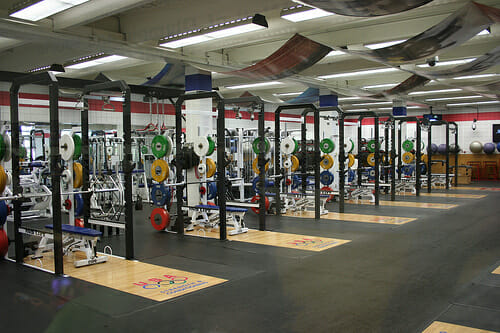The offseason is the time to add base level strength.
February 19, 2015 by Patrick Kelsey in Analysis with 25 comments
It is time for you to get stronger. The post season is officially over now that the new earlier USA Ultimate Series dates have been announced. In order to be invincible from injury and lay down a foundation for performance, you need to start getting stronger now.
Strength is achieved primarily through increasing the load you are lifting, which often means low repetitions on strength movements. “Low repetitions” means different things to different people, and one of the most important factors for determining your optimal rep range is your ‘training age,’ or the length of time you have been strength training. This is different from your playing age. Many ultimate players have many more years of playing experience than training experience since we are typically a non-varsity sport.
The two programs below will help you get stronger. They call for strength training with a higher frequency than that average ultimate player might be used to, but the most important thing to remember when designing or implementing a resistance training program is to listen to your body. A training program like the one below is a very basic framework; every effort should be made to personalize intensity, recovery, and frequency.
I’m not going to get into exercise selection in this article. For now let’s assume that this repetition guide is for bilateral (both legs or both arms) movements like the deadlift, squat, or bench press. Your heaviest lifts.
The first thing you will want to know in order to determine what loads are appropriate is your one repetition maximum (1RM). This is the maximum amount of weight that you can lift cleanly for one rep, but no more. The amount of weight you use during your training will be a percentage based on this number.
You do not necessarily have to do a one rep max test in order to determine this. Here is a handy guide to determine your one rep maximum without having to perform a 1RM test. For example, if you can do five reps of bench press at 175 pounds, then your estimated 1RM is just over 200 pounds.
Even within our program, notice that you never perform a rep at 100%. This allows us to safely gain strength without risking a compromise in lifting form.
For those of you with a high training age: This is the “5/3/1 Program.” I personally like to add an eight repetition warm-up set prior to starting these in order to work out any kinks in the form and see how the lift is feeling.
| Week 1 | Week 2 | Week 3 | Week 4 | |
|---|---|---|---|---|
| Set 1 | 65% x 5 | 70% x 3 | 75% x 5 | 40 % x 5 |
| Set 2 | 75% x 5 | 80% x 3 | 85% x 3 | 50% x 5 |
| Set 3 | 85% x 5 | 90% x 3 | 95% x 1 | 60% x 5 |
Example with a 1RM deadlift of 225 pounds:
| Week 1 | Week 2 | Week 3 | Week 4 | |
|---|---|---|---|---|
| Set 1 | 145 x 5 | 155 x 3 | 170 x 5 | 90 x 5 |
| Set 2 | 170 x 5 | 180 x 3 | 190 x 3 | 115 x 5 |
| Set 3 | 190 x 5 | 205 x 3 | 215 x 1 | 135 x 5 |
For those of you with low training age, your percentages drop by 5% across the board except on the deloading week (week 4). And reps increase to the 4-8 range (with a warmup set of 10 reps). You will still make significant strength gains in this rep range and you will reduce the risk of form breakdown.
| Week 1 | Week 2 | Week 3 | Week 4 | |
|---|---|---|---|---|
| Set 1 | 60% x 8 | 65% x 6 | 70% x 8 | 40% x 8 |
| Set 2 | 70% x 8 | 75% x 6 | 80% x 6 | 50% x 8 |
| Set 3 | 80% x 8 | 85% x 6 | 90% x 4 | 60% x 8 |
Example with a 1RM deadlift of 135:
| Week 1 | Week 2 | Week 3 | Week 4 | |
|---|---|---|---|---|
| Set 1 | 80 x 8 | 90 x 6 | 95 x 8 | 55 x 8 |
| Set 2 | 95 x 8 | 100 x 6 | 110 x 6 | 70 x 8 |
| Set 3 | 110 x 8 | 115 x 6 | 120 x 4 | 80 x 8 |
One thing that I have to remind people of during these types of training sessions is that in-session recovery should be very long, close to three minutes. This is often a good time to work in any other corrective exercises you may want to do, and it’s often best to focus on a different body region entirely. We want to be fully recovered so that we can produce a maximal effort on the next set. Time this if you can: most people will get impatient and try again too soon, but hitting a perfect form personal record will be worth the wait.
